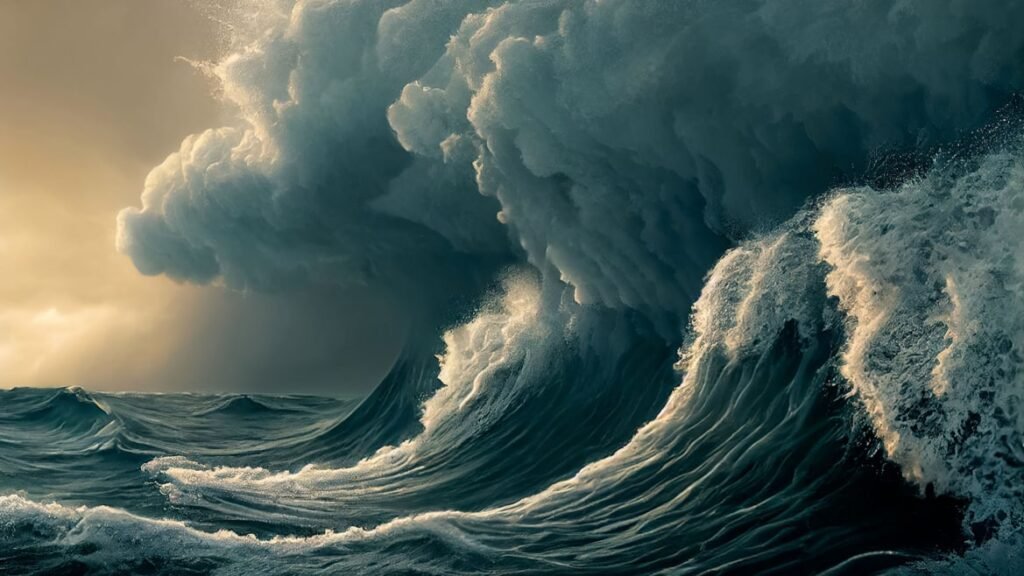The eruption of the Hunga Tonga-Hunga Ha’apai volcano in Tonga on January 15, 2022, triggered a tsunami that rapidly spread across the Pacific Ocean, leading to tsunami warnings being issued by various government agencies in surrounding islands and even distant locations such as New Zealand, Japan, and the U.S. West Coast. Surprisingly, within approximately 12 hours of the eruption, tsunami waves, albeit a few feet tall, reached the shores of California, over 5,000 miles away from the source.

As a physical oceanographer specializing in the study of waves and turbulent mixing in the ocean, I find tsunamis particularly fascinating to teach my students. Despite their seemingly modest height when compared to the devastating images of past tsunamis, tsunamis possess unique characteristics that set them apart from regular ocean waves. Understanding what distinguishes tsunamis, how they are generated, their rapid travel speed, and their immense destructive potential is a captivating exploration into the physics of these extraordinary phenomena.
The eruption of the Hunga Tonga-Hunga Ha’apai volcano had multiple effects, including the ejection of ash into the atmosphere, the creation of a forceful shock wave, and the displacement of a significant volume of water. These combined factors resulted in the formation of a tsunami that swiftly propagated across the ocean.
Most waves we encounter in the ocean are generated by the wind’s interaction with the water’s surface. As the wind transfers energy and displaces the water, it creates the familiar waves we observe at the beach.
Deep displacement
In contrast, tsunamis originate from entirely different processes. They are triggered by significant events such as underwater earthquakes, volcanic eruptions, or landslides that displace a substantial volume of water. The energy released by these events generates a series of waves known as tsunamis. Unlike wind-driven waves, which primarily affect the upper layer of the ocean, the energy of tsunamis extends throughout the entire water column. Moreover, tsunamis involve the displacement of a much larger amount of water compared to wind-generated waves.
To illustrate the distinction, consider the waves produced by blowing on the surface of a swimming pool versus the waves generated by a person performing a cannonball dive. The cannonball dive displaces a significant amount of water, leading to larger and more pronounced waves compared to the gentle ripples caused by blowing on the surface.
Earthquakes and undersea landslides have the potential to displace substantial volumes of water, thus giving rise to dangerous tsunamis. In the case of the Tonga tsunami, the powerful volcanic eruption not only ejected ash but also displaced a significant amount of water. Some scientists speculate that an undersea landslide triggered by the eruption might have contributed to the large-scale water displacement. Further research will be necessary to ascertain the precise factors involved in the event.
This simulation, provided by the National Oceanic and Atmospheric Administration (NOAA), illustrates the propagation of tsunami waves following an earthquake that took place approximately 600 miles away from Tonga in 2021.
Tsunami waves travel fast
Regardless of the cause, once a tsunami is generated and water is displaced, the resulting waves propagate outward in all directions, similar to the ripples created when a stone is thrown into a calm pond.
The speed at which tsunami waves travel is primarily determined by the depth of the ocean. This can be calculated using a simple equation: multiplying the average depth of the ocean (around 13,000 feet or 4,000 meters) by the force of gravity and taking the square root. This calculation yields an average speed of approximately 440 miles per hour (700 kilometers per hour). This is significantly faster than the speed of regular ocean waves, which typically range from about 10 to 30 miles per hour (15 to 50 kilometers per hour).
Oceanographers use this equation to estimate the arrival time of a tsunami at distant coastlines. In the case of the tsunami on January 15, it took 12 hours and 12 minutes for the waves to reach Santa Cruz, California, which is approximately 5,280 miles (8,528 kilometers) away from Tonga. This indicates that the tsunami traveled at a speed of 433 miles per hour (697 kilometers per hour), closely matching the estimated speed calculated using the average depth of the ocean. Many tsunamis, including the 2011 Tsunami in Japan, move inland and can flood areas far from the coast.
Destruction on land
Tsunamis, despite being less frequent than wind-driven waves, can cause significantly more destruction. The immense destructive power of tsunamis can be attributed to several key factors:
Tsunamis are significantly more destructive than normal waves for several reasons:
- Energy concentration: Tsunamis carry a tremendous amount of energy over a wide area. Unlike regular waves that dissipate their energy as they approach the shore, tsunamis retain their energy as they travel across the ocean. This concentrated energy is unleashed when the tsunami reaches shallow coastal areas, resulting in a devastating impact.
- Wave height and wavelength: Tsunamis have much longer wavelengths compared to typical waves. This means that the distance between successive wave crests can be several miles, resulting in a massive wave front. As the tsunami approaches the coastline, the shallowing of the ocean floor causes the wave height to increase dramatically, resulting in a towering wall of water that can inundate coastal areas.
- Inland penetration: Tsunamis can penetrate significantly inland, affecting large areas beyond the immediate shoreline. The combination of their long wavelengths and high energy allows them to travel up rivers, estuaries, and other water channels, flooding coastal communities and causing extensive damage.
- Backwash and multiple waves: Tsunamis are often characterized by a series of waves, with multiple crests and troughs following each other. This series of waves can result in a prolonged and repetitive battering of the affected coastlines, causing additional destruction and making it challenging for people and structures to recover between successive waves.
- Debris and forceful currents: Tsunamis carry a vast amount of debris, including trees, buildings, and other objects, which are swept along by the powerful currents. This debris adds to the destructive force of the waves, causing significant damage to structures, infrastructure, and the environment.
Overall, the combination of the immense energy, large wave height, ability to penetrate inland, multiple waves, and forceful currents makes tsunamis exceptionally destructive compared to normal wind-driven waves.






